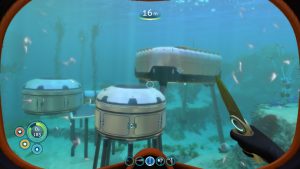Subnautica has been a long time coming. The survival game has been on early access since 2015 and has been a fixture of the early access scene since. With the game finally out, we have a different kind of survival game, and comes close to being one of my favorites of the genre.
Beyond the Sea:
The story of Subnautica takes place in the future. You are a passenger on board the spaceship Aurora, when suddenly the ship crashes on a mysterious planet that is mostly water-based. Your only mission is to figure out how to get off the planet and survive day to day.
Right from the get-go Subnautica establishes that it’s not like your other survival games. Taking place in the ocean gives us one of the most visually stunning survival games out. Each biome is full of sea life and architecture to make it stand out.
The overall environment of the game is hardcoded, but the resource nodes and items you find aren’t. You have to manage thirst, hunger, your overall life, and obviously oxygen at all times, but the game is very lax in this regard. Surviving in Subnautica is the complete opposite of a game like The Long Dark, where reaching any point of sustainability is tough.
Instead, the survival side more or less gives way to open exploration, and I couldn’t be happier.
“Where Life is Grander”
Possibly the biggest design difference in Subnautica compared to other survival game is in the form of progression. In most survival games, there really isn’t a sense of true progression; IE: the player becomes more powerful or unlocks something game changing. Other games are more about the challenge of trying to become sustainable in a world where resources dwindle or break.
Here, the game wants you to become sustainable, so that you can better explore the beautifully designed world. Progression is all about finding the resources you need to build an ever expanding number of options.
At the start, you’ll have to make the most of your escape pod and limited stash for inventory. Start harvesting the mineral nodes and you’ll be able to expand and do more.
The turning point is when you can craft your habitat constructor; allowing you to build a fully-fledged underwater base.
Each new tool or object you can build gives you more power in the game and changes how you play and explore. Swimming at the start is very slow and takes a long time to get around, but given enough time and resources you can construct vehicles to carry you.
This also creates a gating mechanic to the game’s more dangerous areas. There is a linear set of events that happen to move you around the game space, and you will require different tools and items in order to see it all. Dangerous sea life and crushing sea pressure await players who want to dive as deep as they can. The best part is that all the major tools you build are permanent and will not decay. Subnautica provides you with a sense of accomplishment and excitement when you finally build something new or upgrade a pre-existing item.
While Subnautica avoids the frustrating design and traps of other survival games, it can’t fully escape the problems I have with the genre.
Nautical Nonsense:
Subnautica’s gameplay can be broken up into different phases based on the gear and upgrades you’ve unlocked. Combined with the radio transmissions and events give the game some sense of linearity.
For the first half of the game, I was really enjoying my time powering up my base and becoming more versatile in the water. Getting the sea moth upgrade and the utility it provided was the highlight of the game for me.
Unfortunately, entering the back half of the game was when things began to go south. Your mission to get off the planet will lead you into deeper waters which require a lot of construction and grinding. No matter how advanced you get at the game, you cannot escape the need for basic resources, nor is there an easy way to mitigate it.
The player’s own inventory space is very limited compared to the amount of resources required. It’s all but required to set up smaller outposts to reach the deepest depths or scanning rooms for critical resources; that means ferrying resources around the map. There is a lot of dead time that the player will have to deal with. As a positive, you can break down outposts to get the full resources back once you’re done with them.
Probably the most polarized part of Subnautica’s progression is unlocking new objects. There are a lot of objects and upgrades to unlock in the game. The main way is to find copies of them in the world and scan their data.
Unfortunately, many advanced objects designed to push you through the phases of the game are hidden like needles in haystacks around the vast ocean.
I desperately needed a power cell charger for my Cyclops sub, but I only found one and was left with a sub that I couldn’t easily recharge. In two plays of the game, I had a vastly different experience by getting lucky and finding a vehicle modification station. These issues are compounded by a lot of esoteric information that is needed to play Subnautica. There were high level resources that I had no idea where they were located without getting help from chat.
There have also been reported technical issues with the game crashing, long load times on start, and I had the environment flickering in and out as I was swimming along.
One final point to keep in mind, Subnautica is not a game designed around replayability. The basic path through the game remains the same, and the overall environment is fixed.
Deep Treasure:
Subnautica has grown since the early days of early access. If you’re looking for a survival game that goes in a different direction, this is one to check out. There are already talks on expanding the game with more biomes, and the deeper this game gets, the better.
For more on the game, you can watch my recorded streams of it on the Game-Wisdom YouTube channel, and my new player’s guide for getting started.




